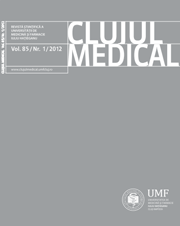The Methylenetetrahydrofolate Dehydrogenase (MTHFD 1) gene G1958A polymorphism and idiopathic male infertility in a Romanian population group
Keywords:
methylenetetrahydrofolate dehydrogenase, idiopathic male infertility, polymorphismAbstract
Background. The folate pathway consists of a complex chain of biochemical reactions essential for the cellular function. Within this pathway C1-THF synthase (C-1-tetrahydrofolate synthase) coded by the MTHFD1 gene is crucial for the conversion of homocysteine to methionine, as well as purine and pyrimidine synthesis. The MTHFD1 G1958A variant could alter the enzyme’s normal activity which may further modify this metabolic pathway.Objectives. To explore the possible association of the MTHFD1 G1958A polymorphism and idiopathic male infertility.
Patients and Methods. Sixty-six male Romanian patients with idiopathic infertility and 67 fertile Romanian men were genotyped for the MTHFD1 G1958A variant, using the polymerase chain reaction – restriction fragment length polymorphism technique (PCR-RFLP).
Results. The 1958A allele had a frequency of 52.27% in the male infertility group, and 45.52% in controls. The comparative analysis between patients and controls genotypes distribution revealed the 1958AA homozygous genotype was more frequent in the male infertility group than in controls (OR = 2.139, p-value = 0.07)
Conclusions. We have found that the variant homozygous genotype might represent a genetic risk factor for idiopathic infertility in our study groups.
Downloads
Published
2012-01-30
How to Cite
1.
Anghel Popp R, Farcas MF, Trifa AP, Militaru MS, Crisan TO, Pop IV. The Methylenetetrahydrofolate Dehydrogenase (MTHFD 1) gene G1958A polymorphism and idiopathic male infertility in a Romanian population group. Med Pharm Rep [Internet]. 2012 Jan. 30 [cited 2025 Nov. 5];85(1):54-8. Available from: https://medpharmareports.com/index.php/mpr/article/view/321
Issue
Section
Original Research
License
The authors are required to transfer the copyright of the published paper to the journal. This is done by agreeing to sign the Copyright Assignment Form. Whenever the case, authors are also required to send permissions to reproduce material (such as illustrations) from the copyright holder.

The papers published in the journal are licensed under a Creative Commons Attribution-NonCommercial-NoDerivatives 4.0 International License.

